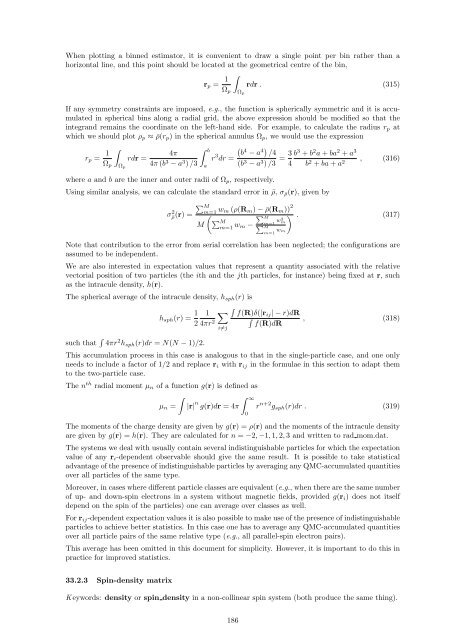CASINO manual - Theory of Condensed Matter
CASINO manual - Theory of Condensed Matter
CASINO manual - Theory of Condensed Matter
Create successful ePaper yourself
Turn your PDF publications into a flip-book with our unique Google optimized e-Paper software.
When plotting a binned estimator, it is convenient to draw a single point per bin rather than a<br />
horizontal line, and this point should be located at the geometrical centre <strong>of</strong> the bin,<br />
r p = 1 Ω p<br />
∫Ω p<br />
rdr . (315)<br />
If any symmetry constraints are imposed, e.g., the function is spherically symmetric and it is accumulated<br />
in spherical bins along a radial grid, the above expression should be modified so that the<br />
integrand remains the coordinate on the left-hand side. For example, to calculate the radius r p at<br />
which we should plot ρ p ≈ ¯ρ(r p ) in the spherical annulus Ω p , we would use the expression<br />
r p = 1 Ω p<br />
∫Ω p<br />
rdr =<br />
4π<br />
4π (b 3 − a 3 ) /3<br />
∫ b<br />
a<br />
r 3 dr =<br />
where a and b are the inner and outer radii <strong>of</strong> Ω p , respectively.<br />
(<br />
b 4 − a 4) /4<br />
(b 3 − a 3 ) /3 = 3 b 3 + b 2 a + ba 2 + a 3<br />
4 b 2 + ba + a 2 , (316)<br />
Using similar analysis, we can calculate the standard error in ¯ρ, σ¯ρ (r), given by<br />
∑<br />
σ 2¯ρ(r) M<br />
m=1<br />
=<br />
w m (ρ(R m ) − ¯ρ(R m )) 2<br />
( ∑ M<br />
) . (317)<br />
∑M<br />
M<br />
m=1 w m=1<br />
m −<br />
w2 m<br />
∑ M<br />
m=1 wm<br />
Note that contribution to the error from serial correlation has been neglected; the configurations are<br />
assumed to be independent.<br />
We are also interested in expectation values that represent a quantity associated with the relative<br />
vectorial position <strong>of</strong> two particles (the ith and the jth particles, for instance) being fixed at r, such<br />
as the intracule density, h(r).<br />
The spherical average <strong>of</strong> the intracule density, h sph (r) is<br />
h sph (r) = 1 ∫<br />
1 ∑ f(R)δ(|rij | − r)dR<br />
∫<br />
2 4πr 2 , (318)<br />
f(R)dR<br />
such that ∫ 4πr 2 h sph (r)dr = N(N − 1)/2.<br />
i≠j<br />
This accumulation process in this case is analogous to that in the single-particle case, and one only<br />
needs to include a factor <strong>of</strong> 1/2 and replace r i with r ij in the formulae in this section to adapt them<br />
to the two-particle case.<br />
The n th radial moment µ n <strong>of</strong> a function g(r) is defined as<br />
∫<br />
∫ ∞<br />
µ n = |r| n g(r)dr = 4π r n+2 g sph (r)dr . (319)<br />
The moments <strong>of</strong> the charge density are given by g(r) = ρ(r) and the moments <strong>of</strong> the intracule density<br />
are given by g(r) = h(r). They are calculated for n = −2, −1, 1, 2, 3 and written to rad mom.dat.<br />
The systems we deal with usually contain several indistinguishable particles for which the expectation<br />
value <strong>of</strong> any r i -dependent observable should give the same result. It is possible to take statistical<br />
advantage <strong>of</strong> the presence <strong>of</strong> indistinguishable particles by averaging any QMC-accumulated quantities<br />
over all particles <strong>of</strong> the same type.<br />
Moreover, in cases where different particle classes are equivalent (e.g., when there are the same number<br />
<strong>of</strong> up- and down-spin electrons in a system without magnetic fields, provided g(r i ) does not itself<br />
depend on the spin <strong>of</strong> the particles) one can average over classes as well.<br />
For r ij -dependent expectation values it is also possible to make use <strong>of</strong> the presence <strong>of</strong> indistinguishable<br />
particles to achieve better statistics. In this case one has to average any QMC-accumulated quantities<br />
over all particle pairs <strong>of</strong> the same relative type (e.g., all parallel-spin electron pairs).<br />
This average has been omitted in this document for simplicity. However, it is important to do this in<br />
practice for improved statistics.<br />
0<br />
33.2.3 Spin-density matrix<br />
K eywords: density or spin density in a non-collinear spin system (both produce the same thing).<br />
186

















